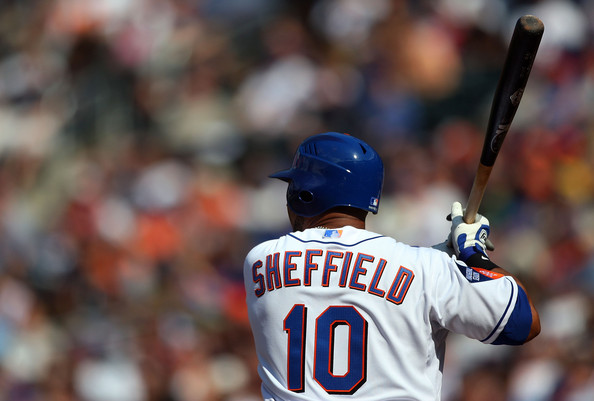There are 10 players eligible for induction into the Hall of Fame who have the Mets on some portion of their resume. Next is one of the most feared hitters of the 1990s and early 2000s whose short stint in New York to conclude his career was highlighted by a personal milestone.
The way Gary Sheffield prepared to swing and swung was much like the way he carried himself. He was a presence that could not be ignored. His ties to the Mets go back to before he made it to the majors thanks to his uncle — Dwight Gooden.
Sheffield is entering his 10th and final chance to be voted into the Hall of Fame by the writers. Last January, he received 55 percent of the vote. That was a nearly 15 percent jump from the previous year, but still 20 percent shy of what he needs for induction. In 2007, Sheffield’s name was included in the Mitchell Report for his ties to performance-enhancing drugs. It’s safe to say that, as murky as it is, has been what’s kept him out to this point.
Over 22 big league seasons, Sheffield played for eight teams, made nine All-Star appearances, collected 2,689 hits, hit 509 homers, drove in 1,676 runs, and stole 253 bases. He was a key member of the 1997 World Series champion Florida Marlins. Five years before that, as a member of the Padres, he made a run at the Triple Crown, ultimately winning the batting title with a .330 average and finishing in the top five in homers (33) and RBIs (100).
He was an All-Star for San Diego, Florida, Los Angeles, Atlanta, and the Yankees. He finished in the top 10 of the MVP voting six times and was a Silver Slugger winner five times — the first coming at age 23 and the last coming at age 36.
But a shoulder injury and an oblique strain hampered Sheffield in 2008. He signed on with the Mets one home run shy of 500. On April 17, 2009, as a pinch-hitter facing Milwaukee Brewers reliever Mitch Stetter, Sheffield reached the milestone. He played the duration of the regular season, ultimately hitting nine more homers before calling it a career.

Gary Sheffield.
The Case For
Take away the connections to PEDs, and the case is strong. Sheffield (60.5) has a higher WAR than Hall of Famers Vladimir Guerrero (59.5), Harmon Killebrew (60.4), David Ortiz (55.3), and Willie Stargell (57.6).
Sheffield was a rarity in the fact that he was a power hitter with plate discipline. He never had a 100-strikeout season. In fact, he never struck out more than 83 times in a season and walked at a 13.5% clip. Among the members of the 500 home run club, only Ted Williams and Mel Ott struck out fewer times than Sheffield. When all was said and done, Sheffield ended up with more walks (1,475) than strikeouts (1,171).
Sheffield was a legitimate middle-of-the order threat for 13 seasons — starting in San Diego, through his seasons with the Marlins, Dodgers, Braves, and Yanks. Although he never won an MVP, the spread of those top-10 finishes is a credit to longevity. Even into his mid-30s, from 2003-05, Sheffield averaged 36 home runs and 125 RBIs per season.
The Case Against
Although he never tested positive for illegal substances, his being in the Mitchell Report is a scarlet letter that he’s yet to overcome. Sheffield’s name came up after authorities found a 2003 FedEx receipt from Sheffield to BALCO in the home of Greg Anderson, a former trainer to Barry Bonds. In his autobiography, Sheffield said he took a cream given to him by Anderson to help heal a knee injury but didn’t know whether it contained illegal substances.
Beyond that, Sheffield has been a bit of a lightning rod. He’s never afraid to speak his mind going back to his days in Milwaukee and even after his career. That might turn off some voters even if there was validity to his statements.
As far as on-field demerits go, his defense is the easiest thing to highlight. His “total zone” and “defensive runs saved” figures aren’t just bad — they are some of the worst in history. His -195 fielding runs rank as the second-lowest total of all time. That brings down Sheffield’s career and peak WARs, as well as his JAWS rating. His 60.5 career WAR ranks 19th among right fielders, which is 10.6 wins below the average Hall of Famer. His 49.3 JAWS is 24th, 7.4 points shy of the average Cooperstown inductee.
As much as defense has helped bolster the profile of players who previously wouldn’t have had as good a case, they can just as well hamper it. This might be a prime example.

Gary Sheffield.
Final Thoughts
Sheffield’s improving percentage gives him some hope, but the trend doesn’t look good enough to get in through the writers. The relaxation on performance-enhancing drug users that should continue in future years will bode well for him. Sheffield has the career totals that merit inclusion in the Hall of Fame, he’ll just have to wait a bit.















